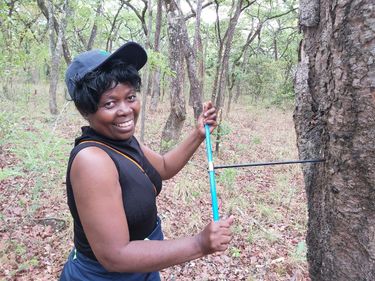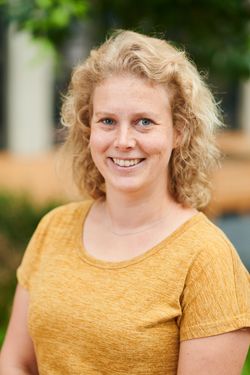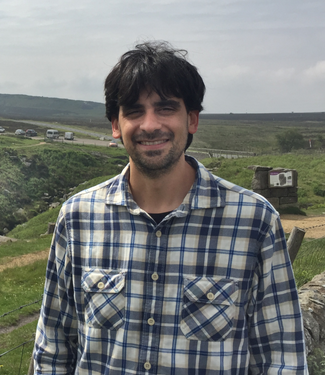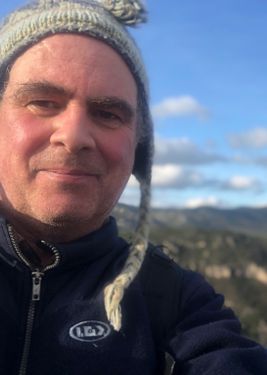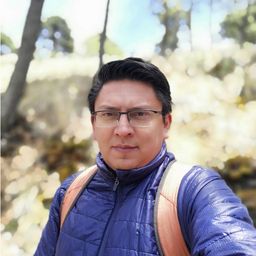
Arian Correa-Diaz
Sessions in which Arian Correa-Diaz participates
Thursday 30 June, 2022
In temperature-limited ecosystems such as high-elevation forests, rising temperatures and increasing carbon dioxide can result in a greening effect, and changes in the phenology and tree growth rates of the forests. We assessed the long-term trend dynamics (greenness and land surface phenology) using the Normalized Difference Vegetation Index (NDVI) and compared them with data from an existing dendrochronological network that came from eight protected mountains in the Trans-Mexican Volcani...
Sessions in which Arian Correa-Diaz attends
Monday 27 June, 2022
MAIDENiso is a numerical process-based model that allows researchers to simulate the growth of a virtual tree. Using daily meteorological data, the model simulates the physical and physiological processes taking place in the tree and its environment, to produce daily and yearly outputs comparable to dendrological observations. The model has been adapted and used successfully in boreal regions in North America. In an inverse mode, tree-ring obs...
Blue Intensity (BI) is a cost-effective analytical method for measuring relative wood density in the rings of conifer tree species. Since early concept papers in the 1990s/2000s, there has been a recent explosion in the application of this method for both dendroclimatology and historical dating as well as other dendro-disciplines. The beauty of BI is that the analytical costs, mainly related to the cost of a h...
Free, in person and onlineWe will hold a practical, skills-based workshop introducing openDendro -- an open-source framework of the base analytic software tools used in dendrochronology in both the R and Python programming languages. openDendro is a new unified set of tree-ring analysis tools in open-source environments that provides the necessary baseline for dendro...
Free, in person and onlineThe stable isotopic compositions of carbon and oxygen (d13C and d18O) measured in tree rings are valuable proxies for reconstructing paleoclimate and are increasingly used as paleophysiological proxies. Applying these proxies in ecophysiology and paleoclimate can be challenging as they rely on complex process-based models and poorly constrained input data. In recent years, h...
Tuesday 28 June, 2022
Africa is faced with a number of challenges including climate change and ecological disturbance due to various anthropogenic activities. These problems adversely affect the forests and also ecosystem services. My appreciation for the forests motivated me to pursure my undergraduate studies in Forestry. I first applied dendrochronology during my PhD research which focused on understanding the climate change vulnerability of the Zambezi teak forests in Zambia. However, lack of research facil...
Tree-ring time series provide long-term, annually resolved information on the growth of individual trees. However, public tree-ring archives contain a considerable portion of data collected from trees that have been selected with specific research questions in mind (e.g., for climate reconstruction). This makes these archives a biased representation of the sensitivity of forest ecosystems to ongoing climate variation (e.g. temperature, precipitation), including non-stationarity (i.e....
As of 2020, 56% of the world’s population live in urban areas. These individuals benefit from numerous ecosystem services provided by urban forests, including urban heat island mitigation, energy use reduction, stormwater interception, wildlife and pollinator habitat provision, air pollution removal, and carbon sequestration. Urban greenspaces are also often the most accessible avenue for exposure to the natural environment, providing additional aesthetic, recreati...
Circulation models forecast changes in global temperature and precipitation that will likely alter forest function. North America is expected to experience increases in intensity and frequency of hot days and nights, and is already experiencing severe and frequent drought and forest fires. Current forest dieback has been attributed to climate change, however forest resilience to climate variability is not well understood. Tree ring records can be used to assess this resilience. In particul...
Wednesday 29 June, 2022
Dendrochronology is considered one the most precise of all the scientific dating techniques. However, it requires long sequences of tree rings and a master record for both the species and region in question. At the University of Groningen, we have been pioneering a new approach to dating that combines the precision of dendrochronology with the versatility of radiocarbon dating. It relies on the detection of spikes in the annual radiocarbon record, thought to b...
Current and projected changes in climate are estimated to be from 10 to 100 times faster than the natural adaptive capacity of trees whose generation times are long. As extreme climatic events are becoming more frequent and exert a strong selection pressure on tree populations, there is an urgent need to better characterize the genetic variability involved in the response of trees to climate. There is currently a lack of knowledge on the role of genetic variability in tolerance to climatic...
Information garnered from historical timbers and wooden artifacts (e.g. houses, barns, ships) can greatly enhance our understanding of human, ecological, and climate history, especially in regions where few old-growth forests and trees remain, tree longevity is relatively short (less than 300-400 years), and environmental conditions break down wood rather quickly, like in mesic to wet regions. Over the last decade plus, the application of tree-ring techniques on wo...
Information garnered from historical timbers and wooden artifacts (e.g. houses, barns, ships) can greatly enhance our understanding of human, ecological, and climate history, especially in regions where few old-growth forests and trees remain, tree longevity is relatively short (less than 300-400 years), and environmental conditions break down wood rather quickly, like in mesic to wet regions Over the last decade plus, the application of tree-ring techniques on woo...
"Drought legacy effects (DLE) in radial tree growth (RTG) have been extensively studied over the last decade and are found to critically influence carbon sequestration in woody biomass. However, the statistical significance of DLE depends on our definition of expected vs. unexpected growth variability, a definition that has not received sufficient scrutiny.Here, we revisit popular DLE analyses using the ITRDB and employ a synthetic data simulation to disentangle four key factors influe...
To determine how trees of a temperate to boreal ecotone forest have responded to climate change and nitrogen deposition we investigated tree-ring growth and stable carbon isotope responses of sugar maple and white spruce at Turkey Lakes Watershed (TLW), in Ontario, Canada. Trees at TLW underwent a dramatic surge in age-adjusted tree basal area increment (ΔBAI) between 1900 and 1970 and have declined thereafter. The early ΔBAI pulse was acutely expressed in sugar maples and white spruce whe...
Soil moisture (SM) is a crucial variable to the energy balance between the soil and the atmosphere. Given the lack of long-term instrumental SM measurements, information captured by satellites and climate reanalysis emerges as a useful tool. In the Mediterranean ecosystems of Chile (MC; 30°-36°S), several studies have reported a forest decline mainly associated with a persistent mega-drought (MD) during the last decade. We evaluated the main spatio-temporal patterns of tree growth during 1...
Increasing frequency of droughts strongly affect the available soil water. Lower water availability was often reported to reduce radial growth not only in climate-limited, but also in optimal areas of tree species distribution. Sampling strategies in dendrochronology focus on specific sites, often in climate-limited conditions. Using tree ring samples collected within National Forest Inventories provides an opportunity to assess growth-climate responses statistically representative o...
Oxygen isotope ratios in tree rings (δ18OTR) from Amazon forests have been shown to provide historical records of rainfall amounts at a large scale, due to the rainout of heavy isotopes during moisture transport. Here, we present a 110-year oxygen isotope record obtained from tree ring-cellulose of six Cedrela odorata trees (rbar = 0.57, EPS = 0.89) from the region of Tapajos River, Eastern Amazon. Our analysis indicates that δ18OTR series reflects inter-annual variability of wet season (J...
Hydroclimate variability in tropical South America is strongly regulated by the South American Summer Monsoon (SASM). However, past precipitation changes are poorly constrained due to limited observations and high-resolution paleoproxies. We found that summer precipitation and the El Niño-Southern Oscillation tarapacana (ENSO) in the Chilean variability and Bolivian are well registered Altiplano in in tree-ring the Central stable Andes oxygen (18–22°S, isotopes ∼4,500 (δ18OTR) m a.s.l.) of...
Photosynthesis and tree-growth are interconnected processes that are independently modulated by environmental variables. The lack of co-located high spatiotemporal resolution measurements of photosynthesis and growth has limited our understanding of their relationship with each other and their environment. Here, we study photosynthesis and tree-growth at near-instantaneous timescales using in-situ and satellite remote-remote sensing, point dendrometers, quantitative wood anatomy, and Pulse...
Spatially-resolved climate field reconstructions are ideal for analyzing spatial anomaly patterns and characterizing regional-scale trends resultant from climate change. To date, few fine-scale, spatially-resolved paleotemperature datasets exist in the Northern Hemisphere. Here, we present a 2.5x2.5o temperature field reconstruction of warm season (April-August) mean surface air temperatures, developed from a network of 130 tree-ring chronologies. In the reconstruction’s current form, stat...
Presentation of all Ameridendro2022 posters.FREE LUNCH FOR ALL ATTENDEES!
This is a mandatory (!) .... and FREE (!!) cocktail & award ceremony (!!!)(in replacement of the Banquet formula)->->->->->->->->->->->->->->->->->->After a great summer day of scientific and urban discoveries in our beloved MTL, we wish to bring together all the AmeriDendro community in one place and congratulate the TRS awardees for their remarkable achievements! -Bonsinsegna award-Fr...
Thursday 30 June, 2022
How old are tropical trees? This fundamental question has long driven the curiosity of laymen and scientists. But only recently, a great number of studies conducted by many brave dendrochronologists resulted in a significant tree-ring-based knowledge that allows us to start accurately estimating tree ages across the globe. As science goes, not only knowing the longevity of tropical trees is essential to understanding forest dynamics and its role in biogeochemical cycles, but one must also ...
Dendrochronological archives in the tropics of the Americas have been under-studied for a long time. Some of the challenges include the Identification of tree-ring boundaries in certain tree species, absence of winter dormancy associated to low temperatures in most of the cases, and logistic difficulties of fieldwork in remote sites. However, part of the slow progress is also related to the fact that historically much less resources have been inv...
In their book chapter in 2011 Gagen et al. (2011) highlighted the need for stable isotope dendroclimatology to move beyond studies that simply demonstrate ‘potential’. This symposium, more than a decade since this publication, will focus on dendrogeochemical studies that demonstrate that the field has moved beyond studies focused on ‘potential’. In particular, this session will strive to identify compelling new insights into unique aspect...
Dendrochronological archives in the tropics of the Americas have been under-studied for a long time. Some of the challenges include the Identification of tree-ring boundaries in certain tree species, absence of winter dormancy associated to low temperatures in most of the cases, and logistic difficulties of fieldwork in remote sites. However, part of the slow progress is also related to the fact that historically much less resources have been inv...
A gap of millennial tree-ring data suitable for dendroclimatology has long been evident in the North American boreal forest. In my talk, I will describe the adaptive approach we have developed to build and improve a data network for millennial dendroclimatology in the eastern Canadian taiga. Recurrence of stand replacing wildfires is the most important constrain to the elaboration of long tree ring chronologies, which can only be developed away from regions ...
The interpretation of stable isotopes in a dendroecological framework can provide powerful insights into how trees adjust physiologically in response to the environment. This symposium aims to bring together researchers who use stable isotopes in tree rings to address ecophysiological responses to environmental changes from intra-annual to multi-decadal resolution. We hope this symposium will enable fruitful discussions and new ideas a...
Allies have emerged as key enablers of diversity and inclusivity initiatives in the workplace, in professional associations, and in everyday life. But what is an ally? What skills are required to be an effective ally? How do we hold ourselves and our community members accountable for being effective allies? This symposium will provide a deeper understanding of what it means to be an ally and the skills to help advance allyship as individuals and as a community. Fur...
